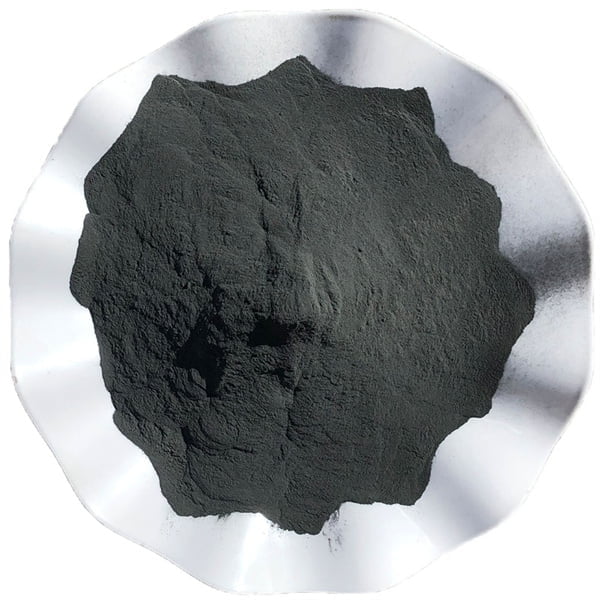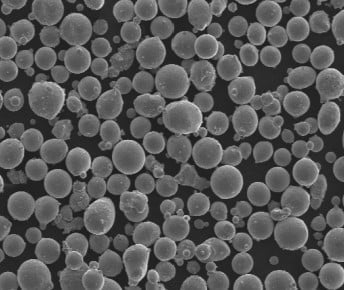ステンレススチール316Lパウダー
目次
ステンレススチール316Lパウダー は、その優れた耐食性、機械的特性、生体適合性により、多くの用途でよく使用される材料です。このガイドでは、316L 粉末の特性、製造方法、用途、サプライヤーなど、316L 粉末の詳細な概要をご紹介します。
ステンレス鋼316Lパウダーの概要
ステンレス鋼316Lパウダーはステンレス鋼合金の一種で、耐食性を高めるためにモリブデンを含んでいる。L "は低炭素を意味し、溶接性を向上させます。
316L粉末の主な特性には以下のようなものがある:
- 優れた耐食性、特に孔食と隙間腐食に対する耐性
- 高い強度と優れた延性
- 生体適合性に優れ、医療用インプラントに最適
- 非磁性オーステナイト組織
- 高温での高い耐酸化性と耐クリープ性
- 様々な粒子サイズと形態で入手可能
316L粉末は、ガスアトマイズ、水アトマイズ、その他の方法で製造することができます。粉末製造プロセスは、粒子形状、粒度分布、流動性などの粉末特性に影響を与えます。
以下は、316L粉末の種類と代表的な用途の比較です:
| パウダータイプ | 粒子径 | 形態学 | アプリケーション |
|---|---|---|---|
| ガスアトマイズド | 15~150μm | 球形 | 積層造形、MIM |
| 霧化された水 | 10-300 μm | 不規則、樹枝状 | 金属射出成形 |
| プラズマ噴霧 | <100 μm | 球形 | 積層造形 |
| 電解 | <150 μm | 樹枝状、とがった | 積層造形、プレス |
| カルボニル | <10 μm | 球形 | 粉末冶金、プレス |
316L粉末は、強度、耐食性、生体適合性を兼ね備えているため、高く評価されています。主な用途は以下の通り:
- 積層造形 - 選択的レーザー溶融、ダイレクトメタルレーザー焼結、バインダージェッティング
- 金属射出成形 - 整形外科用インプラントのような小型で複雑な部品
- プレス・焼結 - フィルター、多孔質構造、自己潤滑性ベアリング
- 表面コーティング - 耐摩耗性と耐食性の向上
- ろう付けおよび溶接 - 溶加材として
ここでは、316Lパウダーがさまざまな製造工程でどのように使用されているかをご紹介します:
| 製造工程 | 316Lパウダーの使用方法 |
|---|---|
| 積層造形 | パウダーベッドをレーザーで選択的に溶かし、3Dパーツを作る |
| 金属射出成形 | 粉末をバインダーと混ぜて成形し、焼結したもの |
| プレスと焼結 | 粉末をプレスして成形し、焼結する。 |
| 表面コーティング | 溶射、レーザークラッディング等により表面に溶射または溶融したもの。 |
| ろう付けと溶接 | 接合用充填材として使用 |
粉末から得られる超微粒子構造と均質な一貫性により、316Lは航空宇宙、医療、化学処理などの重要な用途に理想的な材料となっています。

316Lステンレス鋼粉末の特性
| プロパティ | 説明 | ユーザビリティへの影響 |
|---|---|---|
| 化学組成 | 鉄(Fe)、クロム(Cr)(16-18%)、ニッケル(Ni)(10-12%)、モリブデン(Mo)(2-3%)を主成分とし、ケイ素(Si)、マンガン(Mn)、リン(P)、硫黄(S)、窒素(N)がわずかに含まれる。低炭素 (0.03%未満) | クロムの含有量が高いため、特に孔食や隙間腐食に対して優れた耐食性を発揮する。ニッケルは強度と延性を高め、モリブデンは特に塩化物による局部的な腐食に対する耐性を向上させる。低炭素のため、溶接や高温処理中に炭化物が析出するリスクを最小限に抑えます。 |
| 粒子径と分布 | マイクロメートル(μm)単位で測定され、一般的な範囲は15~50μm。この範囲内の粒子径の分布が重要である。 | 粒子径と粒度分布は、流動性、充填密度、最終製品の機械的特性に大きく影響する。一般に、粒子が細かいほど表面仕上がりが良いが、流動性が悪いため取り扱いが難しい場合がある。粒子径が混在したよく制御された分布は、充填を最適化し、最終製品の空隙を最小限に抑えます。 |
| 見掛け密度 & タップ密度 | 見掛け密度とは、緩く注いだ状態の粉末の密度を指す。タップ密度は、より密に充填するために粉体容器を叩いた後に測定する。単位は通常g/cm³である。 | 見かけ密度とタップ密度の差は、粉末の流動性を反映します。見かけ密度に対してタップ密度が高いほど流動性が良いことを示し、積層造形プロセスにおける効率的な粉末ベッド形成に不可欠です。 |
| 流動性 | 粉体の自重による流れやすさ。ホール流量計やカー指数などの技術を用いて測定される。 | 良好な流動性は、均一な粉末の散布を可能にし、ハンドリングや成膜時の偏析(異なる粒径の分離)を最小限に抑えます。これにより、最終製品の密度や特性が安定します。 |
| 球形度とモルフォロジー | 球形度(Sphericity)とは、粒子がどれだけ完全な球体に近いかを示す。形態は粒子の全体的な形状(球状、角状、不規則)を表す。 | 球状粒子は通常、不規則な形状に比べ流動性が良く、より密に充填される。しかし、用途によっては、所望の表面テクスチャーや粒子のインターロッキングを達成するために、特定の粒子形態が有益な場合もある。 |
| 融点と範囲 | 約1400℃(2552°F)。溶融範囲は粉末の組成によって多少異なる。 | 融点は、焼結や積層造形のような技術において適切な加工温度を決定するために極めて重要である。 |
| 熱伝導率 | 約16W/mK。 | 熱伝導率は、加工中の粉末層内の熱伝導に影響を与えます。これは、冷却速度、残留応力、最終製品における望ましくない相の形成などの要因に影響を与える可能性があります。 |
| 焼結挙動 | 高温加熱プロセス(焼結)中に粉末粒子が結合して固形物を形成する能力。 | 焼結挙動は、粒度分布、粉末表面の化学的性質、焼結パラメータなどの要因に依存します。うまく制御された焼結は、粉末層の緻密化を可能にし、最終製品に望ましい機械的特性をもたらします。 |
| 耐食性 | バルク品である316Lステンレス鋼の優れた耐食性を継承。酸化性酸、還元性酸、塩水噴霧など幅広い環境に耐える。 | 316Lパウダーのモリブデン含有量は、304Lステンレス鋼パウダーに比べ、特に塩化物を含む環境において優れた耐孔食性を発揮します。そのため、高い耐食性が要求される用途に適しています。 |
316L粉末の製造方法
| 方法 | 説明 | 粒子特性 | メリット | デメリット | アプリケーション |
|---|---|---|---|---|---|
| ガス噴霧 | 溶融した316L鋼を高速の不活性ガス気流中に噴射し、微細な液滴に分解して急速に凝固させ、球状の粒子にする。 | - 球状 - タイトな粒度分布(15~45ミクロン) - 優れた流動性 - 高い充填密度 | - 安定した品質 - レーザービーム溶解(LBM)や電子ビーム溶解(EBM)のような積層造形(AM)プロセスに適しています。 | - 高いエネルギー消費 - 酸素と窒素のピックアップの可能性 | - 航空宇宙部品(タービンブレード、熱交換器) - 医療用インプラント(生体適合性のため) - 高性能自動車部品 |
| 水の霧化 | ガスアトマイズと似ているが、溶融金属を破壊するために高圧ウォータージェットを使用する。 | - サテライト(融合粒子)を含む不規則な形状 - 幅広い粒度分布(10~100ミクロン) - ガスアトマイズと比較して低い流動性 | - ガスアトマイズよりもコスト効率が高い - 球形状がそれほど重要でない用途に適している | - 水との相互作用により酸素含有量が高い - AMのために追加の後処理が必要な場合がある | - 流動床反応器(触媒担体) - 金属射出成形(MIM)原料 |
| プラズマ霧化 | 高温・高速のプラズマ・トーチを使用し、316L鋼の原料を溶融・霧化する。 | - 高い球形状 - 細粒化が可能なタイトな粒度分布(5ミクロンまで) - 優れた流動性 | - 要求の厳しいAMアプリケーションのための優れた品質 - 複雑なフィーチャーのためのより微細な粉末を達成することができます。 | - 3つの方法の中で最もエネルギー消費量が多い - 専用設備が必要 | - 高性能タービンブレード - マイクロ流体部品 - 高い表面仕上げを必要とするバイオメディカルインプラント |
| 機械的合金化 | 固体の元素粉末またはプレアロイ粉末をブレンドし、高エネルギーのボールミルで粉砕して、均一な316L組成を実現します。 | - 角ばったファセットを持つ不規則な形状 - 幅広い粒度分布 - 流動性の低下 | - 他の方法では達成できないユニークな合金組成を作るための高度なカスタマイズ性 | - アトマイズ技術に比べて処理時間が長い - AMの流動性を向上させるために追加工程が必要になる場合がある | - 特定の材料特性を必要とする特殊部品 - AM用新合金の開発 |
| 電解 | 316L陽極が電解液に溶解し、金属イオンが陰極に粉末として析出する水系プロセス。 | - 球状または樹枝状 - 幅広いサイズ分布 - 多孔質であることもある | - 高純度パウダーの実現 - ニアネットシェイプ製造の可能性 | - 生産能力が限られている - プロセスに比較的時間がかかる | - 高純度が要求されるバイオメディカルインプラント - 触媒担体 - 特殊な粉体特性が要求される特殊用途 |
316Lステンレスパウダーの用途
| 産業 | 申し込み | レバレッジ物件 | 特記事項 |
|---|---|---|---|
| メディカル&デンタル | * インプラント(膝、股関節、歯科) * 手術器具 * 補綴物 | * 生体適合性(身体との接触に安全) * 優れた耐食性 * 高強度 * 複雑な設計のための成形性 | * 316Lは、拒絶反応や感染のリスクを最小限に抑える。* パウダーは、骨の成長のための多孔質構造の作成を可能にする。* 安全な外科使用のための滅菌が可能。 |
| 食品加工 | * 容器 * チューブ * バルブ * 継手 * ファスナー | * 食品の酸や塩水に対する優れた耐食性 * 洗浄とメンテナンスが容易 * 衛生・安全基準に適合 | * 316Lは食品の品質を保証し、汚染を防ぎます。* 滑らかな表面は、細菌の温床を最小限に抑えます。* 繰り返される洗浄サイクルに耐える。 |
| マリン | * プロペラシャフト * ディーゼルエンジン部品 * デッキ設備 | * 優れた耐塩水腐食性 * 高い機械的強度 * 過酷な環境下での耐久性 | * 316Lは、重要な海洋部品の寿命を延ばします。* ストレスや高負荷の下でも構造的完全性を維持します。* さまざまな温度で確実に行います。 |
| 化学・石油化学 | * 反応容器 * 配管システム * バルブ * ポンプ | * 広範囲の化学薬品に不浸透性 * 高温耐性 * 圧力耐性 | * 316Lは劣化することなく攻撃的な化学物質を扱うことができる。* 効率的な反応のために高い処理温度に耐える。* 製油所やプラントの高圧環境に適しています。 |
| 航空宇宙 | * 航空機エンジン部品 * 流体制御システム * 構造部品 | * 高い強度対重量比 * 高温での優れた機械的特性 * 厳しい環境での耐食性 | * 316Lは燃費向上のため軽量化。* 極端な熱と圧力の下でも性能を維持。* ジェット燃料や他の航空宇宙流体による腐食に強い。 |
| 自動車 | * 排気部品 * エンジン部品 * トリムおよび装飾部品 | * 耐高温性 * 複雑な形状の成形性 * 長寿命化のための耐腐食性 | * 316Lは反ることなく高温の排気ガスに耐えることができる。* 複雑なエキゾーストマニホールドやパイプに形成することができます。* 道路塩や厳しい気象条件からの腐食に抵抗します。 |
| 消費財 | * 腕時計 * 宝石類 * カトラリー * 家電製品 | * ポリッシュ仕上げによる審美的な魅力 * 高い強度と耐摩耗性 * 洗浄が容易で衛生的な耐腐食性 | * 316Lは、高級品にふさわしい、なめらかで高級感のある外観を提供します。* 食器や調理器具の切れ味と耐久性を維持します。* 清潔で衛生的な表面を維持しやすい。 |
| 工事 | * 建築用クラッド * ファスナー * 手すり * ハードウェア | * 高い強度と耐候性 * モダンなデザインへの美的アピール | * 316Lは、錆びることなく厳しい気象条件に耐えることができます。* 時間の経過とともに構造的完全性と機能性を維持します。* 建築要素のためのなめらかで、現代的な一見を提供する。 |
仕様と規格
316L粉末の組成、品質、特性は、様々な国際仕様や規格によって規定されています。
ASTM規格
- ASTM A240 - 圧力容器および一般用途のクロムおよびクロム-ニッケルステンレス鋼板、薄板、帯鋼の規格。316L合金の組成限界と機械的特性を規定。
- ASTM B822 - 光散乱による金属粉末および関連化合物の粒度分布の標準試験方法。粉末の粒度分布の評価に使用。
- ASTM F3055 - 粉末床溶融用途での使用を意図した付加製造用ニッケル合金粉末の標準仕様。316Lを含むAMニッケル合金粉末の厳しい要件を規定。
- ASTM F3049 - 添加製造プロセスに使用される金属粉末の特性評価ガイド。流動性、密度、形態などの特性を測定するためのガイダンスを提供します。
その他の規格
- ISO 9001 - 金属粉末製造の品質管理
- ISO 13485 - 医療用金属粉末の品質管理
- ASMEボイラーおよび圧力容器コード - 圧力容器用途の材料要件
信頼できる316L粉末サプライヤーは、ISOおよびASTM規格の認定を受けた品質システムを有しています。ロットのトレーサビリティと広範なテストは、コンプライアンスを保証するために維持されています。
316L 粉末 供給者
316Lステンレス鋼粉末の世界的な大手サプライヤーには、以下のようなものがある:
| 会社概要 | 生産方法 | パウダーの種類 | 粒子径 |
|---|---|---|---|
| サンドビック | ガス噴霧 | オスプレイ® 316L | 15-45 μm |
| LPWテクノロジー | ガス噴霧 | LPW 316L | 15-63 μm |
| カーペンター | ガス噴霧 | カーペンター316L | 15~150μm |
| ヘガネス | 水の霧化 | 316L | 10-45 μm |
| 中国石油天然気集団公司 | ガス、水噴霧 | 316L | 10-150 μm |
| ポメトン | ガス、水噴霧 | 316L | 10-150 μm |
| エーティーアイ | ガス噴霧 | 316L | 10-63 μm |
316L粉末の価格は、以下のような要因に左右される:
- 粉体の品質、組成、粒子径、形態
- 製造方法
- 注文数量とロットサイズ
- 品質管理とテストのレベル
- 梱包および配送に関する要件
ガスアトマイズ316L粉末の標準価格は1kgあたり$50-100です。特殊な要求のある特注品は、さらに高くなる場合があります。
316L粉末のサプライヤーを選択する際、重要な検討事項には以下が含まれます:
- 粉末の特性(粒度分布、形態、流動性など)は、用途のニーズに適合していなければならない。
- 仕様に沿った一貫した品質と構成
- 信頼性の高いサプライチェーンとロジスティクス
- 国際規格および認証への準拠
- 技術的な専門知識と顧客サービス
- 価格と最低注文数
大手316L粉末メーカーは、AM、MIM、およびその他の用途に合わせた粉末を厳格な品質管理で製造してきた数十年の経験を持っています。
316L粉末の設計上の考慮事項
316Lステンレス鋼粉末の設計上の考慮事項
| アスペクト | 考察 | 印刷部品への影響 | 推薦の言葉 |
|---|---|---|---|
| 壁厚 | 最小厚さは0.8~1mm | 壁が薄い部品は弱く、亀裂が入りやすい。 | * 最適な強度を得るために、少なくとも1mm厚の壁を設計する。* 薄肉部の補強に内部リブや格子の使用を検討する。* 最小限の肉厚が必要な部品については、より高い解像度を持つ別のAMプロセスを検討する。 |
| オーバーハングとアングル | 鋭角のコーナーや支持のない張り出しは、反りや層間剥離の原因となる。 | * フィレットやカーブを取り入れることで、鋭角なコーナーを最小限に抑える。* より良いサポートのために30度から45度の間の角度を持つオーバーハングを設計する。* 垂れ下がることを防ぐために印刷の間に戦略的に置かれたサポート構造を利用しなさい。 | |
| 表面仕上げと方向 | パウダーの特性や層の配向は、表面のテクスチャーに影響を与える可能性がある。 | * 粉末のサイズと形態が表面粗さにどのように影響するかを理解する。* 重要な表面でのレイヤリングの可視性を最小化するために、部品の向きを考慮する。* 研磨やビーズブラストのような後処理技術は、表面仕上げを改善することができる。 | |
| 多孔性 | 部品内に閉じ込められたエアポケットは、機械的特性を損なう可能性がある。 | * 高密度を達成するために、レーザー出力やスキャン速度などの印刷パラメーターを最適化する。* 熱間静水圧プレス(HIP)のような技術を探求し、空隙率をさらに最小化する。* 印刷中のパウダー除去を容易にするために、内部チャネルまたは通気孔を設計する。 | |
| ストレスマネジメント | 印刷工程からの残留応力は、反りやひび割れにつながる可能性がある。 | * 支持構造を戦略的に利用し、応力集中点を最小限に抑える。* フィレットや緩やかなトランジションなどの設計を行い、応力集中を軽減する。* 応力除去アニールのための印刷後の熱処理を考慮する。 | |
| 寸法精度 | 粉末の粒度分布と焼結中の収縮は、最終寸法に影響を与える可能性がある。 | * モデルを設計する際、収縮率(通常20%程度)を考慮する。* 付加製造のための設計(DfAM)の原則を活用して、印刷性を最適化し、寸法の偏差を最小限に抑える。* 印刷パラメーターを較正し、寸法精度を保証するためにテストパーツを印刷する。 | |
| サポート体制 | 複雑な形状に必要な仮設構造は、跡が残ることがある。 | * 除去痕を最小限にするため、接触面積を最小限に抑えた支持構造を設計する。* 後処理を容易にするため、溶解可能な支持材を探求する。* 効率的な材料使用と容易な除去のために、支持構造の設計を最適化する。 | |
| パウダー除去 | 除去しきれなかった粉がキャビティ内に閉じ込められると、機能性に影響を及ぼす可能性がある。 | * 粉の除去を容易にするために、内部溝や排水孔を設計する。* パウダーの滞留を防ぐために、角度のついた特徴や通気孔を利用する。* パウダーの付着を最小限に抑え、流動性を向上させるために印刷パラメーターを最適化する。 |
316L部品の後処理
316Lステンレス鋼部品の後加工
| プロセス | 説明 | メリット | 考察 |
|---|---|---|---|
| サポートの取り外し | 印刷中に使用された仮設構造物の撤去。 | * 最終的な部品形状を得るために不可欠です。* 内部形状へのアクセスを可能にします。 | * 除去方法の選択は、支持体の種類(手動、機械的、化学溶解)によって異なる。* 部品の損傷を避けるため、慎重な取り扱いが必要です。 |
| 熱処理 | * ストレス・リリーフ・アニーリング: 印刷時の残留応力を低減し、寸法安定性を向上させ、ひび割れを防止します。* ソリューション・アニーリング: ミクロ組織を微細化し、機械的特性と耐食性を向上。 | * 部品の性能と寿命を最適化する。* 特定の材料仕様への適合を可能にします。 | * 部品の形状や要求される結果に基づいて、温度と時 間を正確に制御する必要がある。* 溶体化焼鈍には、急冷技術が必要な場合がある。 |
| ショットピーニング | 小さな金属球を表面にぶつけ、圧縮応力層を作る。 | * 疲労強度と耐摩耗性を向上。* 耐応力腐食割れ性の向上。 | * ショットメディアとブラストパラメータの選択は、所望の表面仕上げと効果の深さに依存する。* 過度のピーニングは表面粗さをもたらす可能性があります。 |
| 酸洗と不動態化 | 表面の汚染物質を除去し、耐食性を向上させる化学洗浄プロセス。 | * 過酷な環境にさらされる部品に不可欠。* 強化された防錆のための不動態酸化膜を形成します。 | * 酸洗液と不動態化液の選択は、材料等級と表面状態に依存する。* 化学物質の不適切な取り扱いには、適切な安全予防措置が必要です。 |
| 機械加工と仕上げ | 正確な寸法、公差、表面仕上げを達成するための伝統的な減法技術。 | * AMでは不可能な形状の作成が可能。* 表面の美観と機能性を向上させます。 | * 追加の機械加工の専門知識と設備を必要とする。* さらなる後処理を必要とする熱や応力が発生する可能性がある。 |
| 研磨 | 滑らかな反射面を得るための機械的または化学的方法。 | * 装飾用途の美的魅力を高めます。* 医療機器の表面衛生を改善します。* 改善された耐久性のための表面の荒さを減らします。 | * 琢磨方法の選択は、希望する仕上げのレベルによって決まります。* 過度の研磨は、材料を除去し、部品の寸法を変える可能性があります。 |
| 電気めっき | 別の金属を表面に薄く蒸着させ、特性を向上させること。 | * 導電性、耐摩耗性、耐食性を向上させます。* クロムメッキや金メッキのような装飾的な仕上げを提供します。 | * 電気めっき浴のための特殊な設備と専門知識を必要とする。* 層間剥離を避けるため、めっき厚を注意深く管理する必要がある。 |
316L部品の一般的欠陥
| 欠陥 | 説明 | 原因 | インパクト | 緩和戦略 |
|---|---|---|---|---|
| 多孔性 | 印刷中に部品内に閉じ込められたエアポケット。 | * レーザー出力またはスキャン速度が最適でない。* 不十分な粉末流動性* 不適切なガスパージ | * 機械的強度、疲労寿命、耐食性の低下。* 流体用途では、漏れ経路を作る可能性がある。 | * 適切な溶融と密度のために印刷パラメーターを最適化する。* 流動性を改善するためにパウダーベッドを予熱する。* 不活性ガスパージを利用して、閉じ込められた空気を最小限に抑える。* さらなる高密度化のために、熱間静水圧プレス(HIP)のような後処理技術を検討する。 |
| 融合の欠如 | 隣接する粉末層間の溶融が不完全。 | * レーザー出力密度の不足* 粉末層の厚さが一定でない。* 粉末表面の汚染 | * 層間接着が弱く、ひび割れや部品の破損につながる可能性がある。 | * 適切な溶融深度を得るために、レーザー出力とスキャン速度を較正する。* 適切な再コーティングメカニズムにより、一貫した粉末層の厚さを確保する。* 水分や汚染物質のない清潔なパウダーベッドを維持する。 |
| バロニング | 溶融金属が上面に過剰なビーズ状に蓄積。 | * 過度のレーザー出力密度。* 不適切なスキャン速度* 不適切な粒度分布 | * 美観に劣る粗い表面仕上げ。* スパッタや工程が不安定になる可能性。 | * オーバーヒートを防ぐため、レーザー出力を下げるか、スキャン速度を上げる。* 単一領域での過剰な滞留時間を避けるためにスキャンパターンを最適化する。* 一貫した溶融挙動のために、より均一な粉末サイズ分布を利用する。 |
| ひび割れ | 残留応力や熱衝撃による部品の破壊。 | * 印刷中の急冷。* 後処理での応力除去が不十分。* 応力を集中させる鋭角やデザインの特徴。 | * 構造的完全性が損なわれ、部品が故障する可能性がある。 | * 印刷時の冷却速度を遅くし、熱勾配を最小限に抑える。* 残留応力を低減するために応力除去アニールを行う。* 鋭角を避け、滑らかな形状を設計する。 |
| 反り | 部品が意図した形状から歪むこと。 | * 印刷中の不均一な熱膨張と熱収縮。* 複雑な形状に対する不十分な支持構造。* 部品に閉じ込められた残留応力。 | * 寸法の不正確さと部品の誤作動の可能性。 | * 印刷パラメータを最適化し、熱勾配を最小限に抑える。* 印刷中の適切な支持のために戦略的に配置された支持構造を利用する。* 反り傾向を減らすために応力除去アニールを実施する。 |
| デラミネーション | 部品内の層の分離。 | * 融着不足による層間結合の弱さ。* 粉末中の水分過多。* パウダーベッド上の汚染。 | * 構造的完全性の喪失と部品の剥離の可能性。 | * 印刷パラメーターを最適化することにより、層間の適切な融合を確保する。* 適切な保管と取り扱いにより、パウダーの含水率を低く保つ。* 汚染物質のない清潔なパウダーベッドを使用する。 |

316Lパウダーサプライヤーの選び方
ここでは、316Lステンレス鋼粉末のサプライヤーを選択するためのステップバイステップのガイドを示します:
ステップ1:応募条件の決定
- AM、MIMなど、どの製造プロセスを使用するかを検討する。
- 粒子径、形状、純度など、必要とされる重要な粉末特性を特定する。
- 機械的特性、精度、表面仕上げなど、部品の仕様を検討する。
ステップ 2: サプライヤー候補の調査
- 長い経験を持つ主要な316Lパウダーメーカーの検索
- 製造方法、パウダーの品種、QCテストなど。
- お客様のアプリケーションに関連するケーススタディとカスタマーレビューをご覧ください。
ステップ3:技術力の評価
- 316Lパウダーを用途に合わせてカスタマイズすることは可能ですか?
- AM、MIM、その他の粉体技術に精通しているか?
- 垂直統合と品質管理のレベルは?
ステップ4:サービス内容の評価
- 粉体選定、アプリケーション開発における技術サポート
- サンプルテスト、トライアリングサービス
- 問い合わせへの対応、リードタイムの柔軟性
ステップ5:認証とコンプライアンスの確認
- 国際品質認証 - ISO 9001、ISO 13485など
- ASTMなどの粉体組成規格に準拠
- ロットのトレーサビリティ、広範なテストと文書化
ステップ6:価格比較
- 要求される粒度、品質レベル、数量に対するkg当たりの価格
- 最小発注量およびロットサイズの要件
- 配送/物流コスト
ステップ7:可用性と信頼性のチェック
- 安定した在庫供給と需要変動への対応力
- 注文の追跡と監視、透明性の高いリードタイム
- 納期厳守の実績
アプリケーションの専門知識、一貫した製品品質、迅速なサービスを備えたサプライヤーを選択することで、スムーズな調達が可能になります。
316L粉末をAMに最適化する方法
粒子径をAMプロセスに合わせる
- DMLS、SLMのような粉末床溶融に10~45μmの粒子を使用
- サイズ分布の最適化 - 広すぎるとパッキングに問題が生じる可能性がある
- バインダージェットに適した1~10μmの微細粒子
高い真球度と流動性を実現
- 流動性は粉体の広がりと層の均一性に直接影響する。
- ガスアトマイズにより、球状の自由流動性粉体を製造
- ASTM B213規格に準拠したパウダーフロー試験
衛星粒子の最小化
- ふるい分け、分級を行い、衛星や微粉を除去する。
- サテライトは凝集や欠陥の原因となる。
コントロール組成の許容範囲
- ASTM規格の範囲内で元素組成を厳密に管理
- 特性に影響を与えるO、N、Cなどの不純物を制限する。
気孔率を下げる
- プロセスパラメータとスキャンパターンの最適化
- 熱間静水圧プレスで空隙を最小限に抑える
- 99%以上の密度を維持し、高性能を実現
残留応力の最小化
- 製造工程における熱勾配の最適化
- 応力を緩和するために適切な熱処理を行う
目標の機械的特性を達成する
- 固溶化熱処理と時効処理により強度が向上
- すべてのビルド方向で均一な特性を維持する
AMを使用して欠陥のない316L部品を実現するには、粉末の特性評価、パラメータの最適化、後処理を慎重に行うことが重要である。
よくあるご質問
Q: 316Lステンレスパウダーは一般的に何に使用されますか?
A: 316L粉末は、優れた耐食性と機械的特性、生体適合性を兼ね備えているため、積層造形、金属射出成形、プレス・焼結用途に最も広く使用されています。一般的な用途としては、インプラント、航空宇宙部品、自動車部品、生体医療機器、工具などがあります。
Q: レーザーベースのAMプロセスでは、どの程度の粒子径が推奨されますか?
A: DMLSやSLMのようなレーザー粉末溶融プロセスでは、一般的に10~45ミクロンの粒度範囲が推奨されます。10ミクロン以下の微細な粒子は、流れや広がりに問題を引き起こす可能性があります。粒度分布も十分に制御する必要があります。
Q: 粉末の形態は特性にどのような影響を与えますか?
A: AM用途には、球形で流動性の高いパウダーが望ましい。不規則でとがったパウダーはプレスや焼結法に適しています。衛星粒子や微粉は粉末の流動性に悪影響を与え、欠陥を生じさせる可能性があります。パウダーモルフォロジーをコントロールすることが、最適なパフォーマンスを得るための鍵となります。
Q: ガスアトマイズと水アトマイズの316Lパウダーの主な違いは何ですか?
A: ガスアトマイズされた 316L 粉末は、より球状で流動性に優れています。水アトマイズ粉末は、より不規則な形状を示しますが、プレスや焼結用途に必要な高い圧縮性が得られます。ガスアトマイズ粉末は酸素含有量が低い。
Q: 316L AM 部品にはどのような後処理方法が使用されていますか?
A: 一般的な後加工には、熱処理、熱間静水圧プレス、研削・機械加工による表面仕上げ、コーティング、品質管理試験などがあります。これは、目標特性、寸法精度、美観、欠陥検出の達成に役立ちます。
Q: 316L 粉末の一般的な欠陥とその回避方法は?
A: 欠陥の可能性とは、気孔、割れ、表面仕上げ不良、融 着不足、残留応力などです。プロセスパラメーターの最適化、粉末の品質管理、造形方向、後処理を注意深く行うことで、316L部品のこれらの欠陥を最小限に抑えることができます。
Q: AMやその他の用途の316L粉末にはどのような規格が適用されますか?
A: 主な規格は、AMパウダーのASTM F3055、パウダーの特性評価のASTM B822、合金組成のASTM A240、品質管理のISO規格です。主要な316L粉末サプライヤーは、これらの規格の認証を受けています。
Q: 316L粉末の価格決定要因は何ですか?
A: 316Lパウダーの価格設定に影響を与える主な要因は、品質レベル、粒子径と分布、製造方法、注文数量、テスト/QC、梱包、納品に関するバイヤーの要求です。要求が厳しいほど価格も高くなります。
Q: 316L AM部品の耐食性はどのように最適化できますか?
A: 化学組成の公差を厳しくして不純物レベルをコントロールする、熱間静水圧プレスで密度を高めて気孔率を下げる、不動態化処理を施す、耐食性を向上させるために溶体化処理を施すなどの解決策があります。
シェアする
MET3DP Technology Co., LTDは、中国青島に本社を置く積層造形ソリューションのリーディングプロバイダーです。弊社は3Dプリンティング装置と工業用途の高性能金属粉末を専門としています。
関連記事
Met3DPについて
最新情報
製品

3Dプリンティングと積層造形用金属粉末









